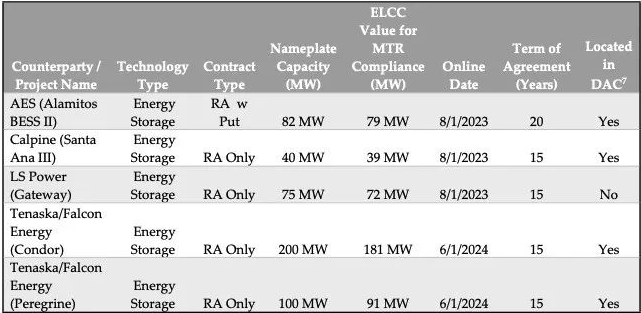The California Public Utilities Commission (CPUC) has approved 497MW of energy storage systems purchased by Southern California Edison (SCE), commissioned between August 2023 and June 2024.
CPUC has signed five contracts for battery energy storage systems, with a nominal power of 497MW and a total capacity of 1988MWh. The duration of each design is 4 hours.
These stand-alone lithium-ion battery energy storage systems are procured by SCE through a "fast-track" process for 15 to 20 years, ensuring that they can be put into operation before the planned deadline.
The following table lists information on these projects, including new construction, renovation, and expansion projects. For example, when commissioned in August 2020, LS Power's 250MW/250MWh Gateway project was the largest battery storage project in the world at the time. The ELCC in the table is the term for CPUC/CAISO, which is used to characterize the effective capacity of the energy storage system converted to the ideal lossless time-consuming energy storage system. The ELCC power of these five systems is slightly lower than 500MW, which is about 462MW.
Last summer, the CPUC ordered the state's three major utilities to procure and deliver 11,500MW of clean electricity between 2023 and 2026. The five battery storage projects will help SCE achieve its capacity to complete.
Commissioner Genevieve Shiroma commented: "The 500MW of energy storage we have approved today will greatly enhance our ability to maintain grid reliability during peak electricity consumption periods. These five energy storage projects are critical to reducing our dependence on fossil fuels. "
Battery energy storage in the CAISO grid
CAISO approved 3GW of battery storage to connect to its grid in April this year, and these units are now shifting up to 6GWh of energy per day from low-demand, low-price periods in the morning to peak high-price periods. Still, the power source is mostly natural gas rather than renewable energy.
Buying and selling electric energy arbitrage in the market is now a major function of battery storage projects in the state, with a small need for frequency regulation. Some utilities use battery storage units to provide services to customers who have sufficient power resource requirements. CAISO plans to require these utilities to maintain a certain capacity margin.
SDG&E targets battery storage investment
Another California utility, SDG&E, recently submitted its budget proposal to the CPUC for 2024-2027, including some planned energy storage investments. It said it would invest in modernizing the grid with various technologies, integrating renewable energy, and developing energy storage and electric vehicle charging infrastructures.
It also calls for the greater installation of utility-scale battery storage in some areas, maximizing the use of photovoltaics, providing more reliable services to customers, and upgrading microgrids in areas with battery storage units.
